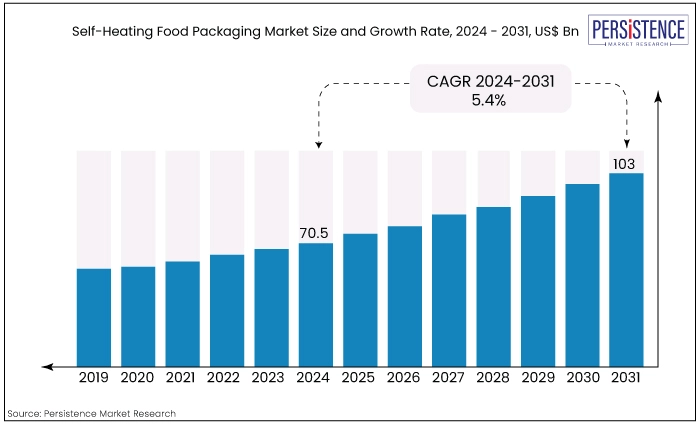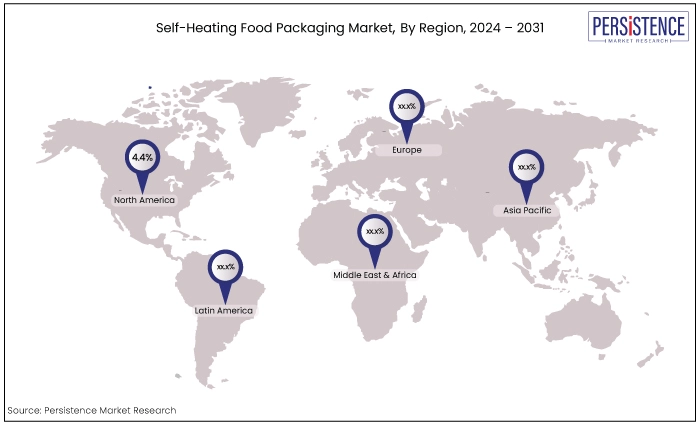Industry: Chemicals and Materials
Format: PPT*, PDF, EXCEL
Delivery Timelines: Contact Sales
Report Type: Ongoing
Report ID: PMRREP34672
The global self-heating food packaging market is estimated to value at US$103 Bn by the end of 2031 from US$70.5 Bn recorded in 2024. The market is expected to secure a CAGR of 5.4% in the forthcoming years from 2024 to 2031.
Key Highlights of the Market
|
Market Attributes |
Key Insights |
|
Self-Heating Food Packaging Market Size (2024E) |
US$70.5 Bn |
|
Projected Market Value (2031F) |
US$103 Bn |
|
Forecast Growth Rate (CAGR 2024 to 2031) |
5.4% |
|
Historical Growth Rate (CAGR 2019 to 2023) |
4.6 % |
The self-heating food packaging market focuses on innovative packaging that heats food without external heat or power, utilizing an exothermic chemical reaction and water. This technology is invaluable during military operations, natural disasters, and for outdoor enthusiasts.
Primarily used for main courses like meat dishes, self-heating food packages offer the convenience of hot meals anywhere, eliminating the need for a microwave.
The market is driven by the demand for portable, ready-to-eat meals in situations where conventional cooking is not feasible, as well as by busy lifestyles seeking convenient food solutions.
Advancements in eco-friendly materials and faster heating technologies are further propelling market growth.

The self-heating food packaging market has seen notable growth driven by increasing demand for convenience, on-the-go meals, and advancements in technology.
Historically, the market experienced a surge with the rise of urbanization, busy lifestyles, and military applications. The COVID-19 pandemic further boosted the market as consumers sought innovative and safe food packaging solutions.
The market is poised for continued expansion due to the growing outdoor recreational activities and the increasing adoption of self-heating technology in various sectors such as emergency relief and space missions.
Innovations in eco-friendly and sustainable packaging materials are expected to play a crucial role in future growth, catering to the rising consumer preference for environmentally conscious products.
The market will also benefit from ongoing research and development, enhancing the efficiency and safety of self-heating mechanisms.
Shifting Consumer Preferences
The food and beverage sector has grown significantly due to consumer trends, tastes, and specialized interests.
In recent years, there has also been a substantial shift in packaging patterns in the food and beverage industry due to customer demand for ready-to-eat, convenient, modestly processed food items with excellent quality standards and prolonged shelf-lives.
Due to changes in lifestyle, food packaging has changed significantly in the modern era, with self-heating packaging gaining popularity.
The packaging industry is quickly abandoning outdated packaging techniques in favor of more innovative ones that have emerged recently, like bioactive, active, and intelligent packaging.
Busier Lifestyles
Fast-paced consumer lifestyles have opened new business prospects for the food & beverage packaging sectors, especially in global cities.
Over the past few years, despite stakeholders' increased attempts to create novel packaging solutions, interest in self-heating food packaging solutions has surged.
The self-heating food packaging industries are using heat insulator layers more frequently to keep ambient heat from affecting the food within food containers.
Growing Use of Chemicals as a Heat Source
The complexity of producing self-heating food packaging and integrating its mechanisms into traditional production processes poses a significant challenge.
The increasing use of chemicals as heat sources in Self-Heating Food Packaging Market is notable. Exothermic reaction chemicals, while effective, pose environmental challenges and complicate recycling processes.
Additionally, the high cost of these chemicals raises the overall price of self-heating food cans, potentially limiting market growth. These factors present significant obstacles to the expansion of the market, as consumers and manufacturers alike seek more cost-effective and environmentally friendly solutions.
Addressing these issues through innovation and sustainable practices will be crucial for the market's continued development and acceptance during the projected period.
Insufficient Customer Awareness
Traditional packaging styles remain prevalent in industrialized regions such as North America, and Europe. Despite the convenience of on-the-go self-heating food, consumer awareness of its benefits is still limited.
The lack of knowledge hampers the adoption of self-heating packaging solutions, as many consumers continue to prefer conventional methods.
Increasing consumer education and promoting the advantages of self-heating food packaging will be essential for greater market penetration and growth in these regions.
Individualization of the Market
Customization is a significant trend driving the self-heating food packaging market. The rising demand for personalized products and experiences has led to an increase in innovative, patented self-heating packaging technologies.
Such advancements cater to diverse consumer preferences, enhancing convenience and usability. Additionally, the shift towards holistic products, which prioritize both functionality and sustainability, is influencing consumer choices.
As manufacturers respond to these trends by developing tailored solutions, the global market for self-heating food packaging is expected to experience robust growth during the forecast period. This focus on customization not only meets individual consumer needs but also positions brands competitively in an evolving marketplace.
Several Advantages of Food Packaging that Heats up on its Own
Self-heating food packaging is a very useful solution for food and beverage packaging. Customers may quickly and conveniently reheat food and drink items in self-heating packaging no matter where they are.
Fast-moving commuters can save time and energy by consuming meals and beverages on the fly when they use products in self-heating packaging.
It is projected that the advantages self-heating food packaging has over conventional packaging solutions would increase consumer acceptance of the former and encourage market growth for this kind of packaging.
|
Category |
Projected CAGR through 2031 |
|
Packaging Type - Containers |
4.1% |
Containers to be the Most Widely Sought-After Packaging Type
It is projected that the self-heating packaging market will be dominated by the containers industry, which generated substantial income in 2024. The growing popularity of the self-heating container among travelers and its convenience of use may have contributed to the category's expansion.
However, because of their portability and effective heat up, cans are expected to demand a significant market share in the years to come.
Furthermore, manufacturers are introducing smart packaging devices such as sensors, temperature indicators with timers, self-heating and self-cooling container, including electronic screens in this clever bundle. This factor is expected to drive the self-heating food packaging market's growth throughout the projected decade.
|
Region |
CAGR through 2031 |
|
North America |
4.4% |
North America Spearheads with an Estimated Market Share of over 40%
North America is leading the world market for self-heating packaging, which can be attributed to the growing number of consumers there who desire food to be consumed quickly and have busier, faster lifestyles.
Over the course of the forecast period, North America is expected to hold a larger than 40% market share in the worldwide market.
With the growing need for food packaging that can be taken with you wherever you go in these regions, millions of dollars have been spent on research and development in the global self-heating food packaging market to create self-heating packaging solutions.
To build self-heating beverage cans, the US-based beverage packaging company HeatGenie, LLC-which makes aluminum cans that heat themselves-has been awarded US$ 6 million by ARTIS Labs. Additional funding for the project has come from private individuals, and Almanac Investments.

The self-heating food packaging market is characterized by a blend of established companies and emerging startups. Major players are focusing on innovation, developing patented technologies for enhanced heating efficiency and sustainability.
Collaborations with food brands are common to expand product offerings. Start-ups introduce novel solutions, targeting niche markets. Regulatory compliance and safety standards are crucial in shaping product development and market strategies.
The competitive landscape is dynamic, driven by technological advancements and evolving consumer preferences for convenience and eco-friendly packaging options.
January 2024
Nestlé partnered with Self-Heating Technologies, Inc. to co-develop new self-heating packaging for their ready-to-eat meals, focusing on enhancing consumer convenience.
February 2024
HotCan launched a new line of self-heating snacks that use advanced thermal technology, ensuring safe and efficient heating. This innovation caters to growing consumer demand for convenient and ready-to-eat food options.
March 2024
Amcor plc acquired Eco-Products, Inc., enhancing its portfolio with innovative sustainable materials for self-heating food packaging, furthering its commitment to sustainability and environmentally friendly packaging solutions.
|
Attributes |
Details |
|
Forecast Period |
2024 to 2031 |
|
Historical Data Available for |
2018 to 2023 |
|
Market Analysis |
US$ Million for Value |
|
Key Regions Covered |
|
|
Key Market Segments Covered |
|
|
Key Companies Profiled in the Report |
|
|
Report Coverage |
|
|
Customization & Pricing |
Available upon request |
By Packaging Type
By Application
By Region
To know more about delivery timeline for this report Contact Sales

The demand is surging due to increasing consumer preferences for convenience, on-the-go meals, and innovations in sustainable, efficient heating technologies that enhance food safety.
Some of the key players operating in the market are Nestlé S.A., Crown Holdings, Inc., HotCan, and Self-Heating Technologies, Inc.
Containers segment recorded the significant market share.
A compelling opportunity in the self-heating food packaging market lies in developing eco-friendly solutions that appeal to environmentally conscious consumers, along with targeting niche markets such as military, outdoor activities, and emergency preparedness sectors.
North America accounts for a significant share of this market.